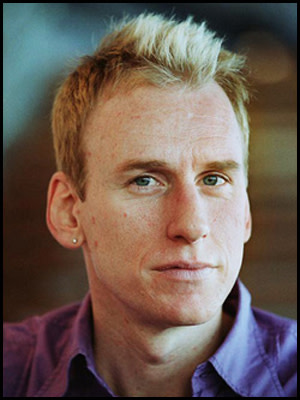Q&A: Meet OBT’s New Artistic Director

Image: I-DANCE
First, a little straight-talk ballet catch up with Goldstein. The ballet’s struggle with its balance ledger has been a well-publicized problem since the 2009 star-studded bailout performance and became newly apparent when it was reported to owe $300,000 to PCPA for past rent. “The art was not a problem,” says Goldstein. “But the management of the organization wasn’t equal to the art. We’ve uncovered one thing after another [in the organization’s finances], so we were always digging ourselves out of a hole.”
In October, the board had a meeting with a bankruptcy lawyer and several donors in which a small number of board members said that they didn’t think it was possible to get out of the hole. Their solution: drop the curtain on the ballet once and for all. Ultimately, the board decided that the ballet should keep going, but six members resigned as a result, leaving just 10. When they told then artistic director Christopher Stowell that the company needed to tighten its belt, he said he wasn’t the one to do it and gave his 30-day notice, surprising everyone. (Read our exclusive interview with Stowell).
Thanks to the success of the Nutcracker, the season’s other programming, and a recent fundraiser that netted $200,000, Goldstein says the organization closed the season with a very small surplus (and a three-year payment plan with PCPA). The board, meanwhile, has grown to 22 members, including several former chairs, and is stressing its business approach to the nonprofit’s budget, which is to say a much tighter fist.
Celebrating Balanchine
Keller Auditorium
June 14–16Into this transition, enter Irving, whose confidence is as apparent in the conference room as it once was on the stage. He danced for Les Grands Ballets Canadiens and Twyla Tharp Dance before going on to be ballet master with Nacho Duato's Compañia Nacional de Danza in Spain for eight seasons and then the artistic director of the Göteborg Ballet in Sweden from 2002–2007, as well as a frequent guest ballet master with the Royal Danish Ballet since. (For a more complete bio, see our original post.)
In our conversation, we talked about Irving's artistic vision, his plans for reaching wider audiences, and the amount of shows he plans to choreograph: 0. Watch for a profile of Irving in our Fall Arts Guide.
Culturephile: You live in Brooklyn and run the nonprofit I-DANCE, as well as teach all over the world. Why were you interested in this job?
Irving: My partner Nicolo [Fonte] has worked here many times and been very successful with the company and the organization. I’d been here for the first time in 2008 and been back since to see the company and Nicolo working, so I had already fallen in love with the city and formed a really high opinion of the company. I decided to throw my hat in the ring because it represented a good match for me in terms of what my artistic vision is and what the company’s done in terms of community.
Tell us about that vision.
What’s so exciting about classical ballet in the 21st century is having the ability to reach into a treasure trove—not just the 18th and 19th centuries, but all of the 20th century classics. Rather than having a narrow focus, the way of moving ballet forward is to do work that in some way, shape, or form is contemporary. That’s who I am. I was not a child brought up in classical ballet.
I want to see classical ballet in the repertoire, but I also want to bring new works by choreographers like Nacho Duato and Jirí Kylián, who I have relationships with. I’m looking to excite the audience for what ballet stands for and what it can be.
We’re seeing different models in some of the other classical organizations, like Chamber Music NW and the symphony, who’re doing series in bars and nontraditional venues to try to reach a different audience. Do you see other means to reach the audience than the Keller Auditorium?
The philosophy for me is: we aren’t sitting inside our golden cathedral knowing that we’re beautiful and waiting for people to come in and pay homage. Our responsibility is to go out and meet people in places where they don’t expect see us, without a big buy in.
One thing I produced a year and half ago with Morphoses [Dance Company] was the first livestream event from the Joyce Theater. We were looking for a way to find an audience that would not be going to the theater, so we livestreamed the performance in closed channel to a hamburger bistro in the Lower East Side and to a community center up in the Bronx that was a very different demographic. It was really high quality television, but it was a shared experience. It wasn’t just putting it on the web so somebody could look at in their pajamas.
It opened a conversation. I want to invest more time and talent into looking for those stepping stones. We have to find a way to bring people into the theater, because it’s an art form that only exists when it’s shared.
How do you intend to do that here?
One thing we’ve overlooked for a long time is that as soon as you cross the threshold, you’re in the experience. I’m thinking of Sleep No More [an incredibly successful immersive performance event in New York) or haunted houses. I’m not saying we will turn the Keller into haunted house, but what’s important is the magic and the feeling that’s generated.
But do you have specific examples in mind?
I wish you wouldn’t pin me down. I don’t want to kill excitement by giving it away. Allow me to be general. I’m talking about people’s expectation of going to the ballet. You go in milling about, sit down, the curtain goes up—that whole rote thing is something I want to shake up and reinvigorate. I plan on being very creative and thinking a little out of the box while respecting our tradition.
Talk about moving forward within the budget constraints. How will it affect things like the company’s ability to do big story ballets?
There’s no doubt about it that next year going to be lean. We’ve cut to the bone, which I think is a good advantage for me coming in because we’re going to be able to grow organically. But at the same time, we’ll never lose sight of the fact that part of our obligation is to delight and entertain the audience, so we’re going to be telling stories. We’re not going to be able to put on Sleeping Beauty next year, but it is in our future and we’re going to get there.
What about the size of the company? Will you be shrinking it?
At the end of this year there were four dancers who elected to leave, and two are retiring. I believe that had a lot to do with uncertainty—they had to decide in January or February whether to stay on, and sadly they’re leaving. The decision was made to not replace them for now. The company has shrunk in size; we’re down from 25 or 26 to 20.
Lucas Threefoot is going to Ballet de Monte Carlo. He’ll be very successful, but he’s a hometown boy, so he might come back. Grace Shibley and Julia Rowe are going to the San Francisco Ballet. And Javier [Ubell] is going to Staat Ballet Munchen.
Do you plan to choreograph?
[Holds up his hand in a big 0]. I plan to choreograph that much. [When I was young], I was given a commission to choreograph for a company in Toronto. I was very full of myself. I did a piece and got paid. A couple of months went by, and I looked at and it was awful. I would be at best mediocre, and I realized there’s no point for another mediocre choreographer to take up space.
There’re certainly lots of artistic directors who choreograph, and it’s not always bed of rose. And then there are directors like myself who consider themselves curators. But in 2013, there are more advantages to someone like myself. I think very few choreographers can sustain their vision given the amount of output demanded over 10 years.
What role will Nicolo play?
Nicolo will definitely be in the planning. One of the attractions to me of the company was that his aesthetic and combination of skills was so well received by the company and audience here—that said a lot of what I going to be walking into. I have a very close relationship with Nicolo, Nacho Duato, Jirí Kylián, Twyla Tharp, the Balanchine trust.
Goldstein: We were stunned by the level of applicants—we feel like we got the elite cadre of people. We had stock questions on the selection committee: who’s your biggest influence. We were really pleased when we met with Kevin, and he said here’re the people I’d be bringing. Almost everybody gave the list of people that he knows well personally.
Anne [Mueller, the interim artistic director] was the other finalist, correct? Do you know what she will do?
Irving: At this point, Anne is weighing her options. As I understand it, when she agreed to take on the interim director position, it was agreed she’d have the option of returning to her former position. As I understand it, she’s very interested in the executive side of things. One thought is she finds a position to develop the skills in that realm, because she’s obviously very gifted.
What about the other executive positions that have long sat empty?
Goldstein: We’re looking for a development director, a marketing director—we have an interim—and we’re looking for an executive director. So the same search committee that was looking for the artistic director is now looking for the executive director.
And Culturephile will be sure to keep you up to date on that search. For a profile of Irving that gets more into his personality and history, watch for our Fall Arts guide in our September issue.




